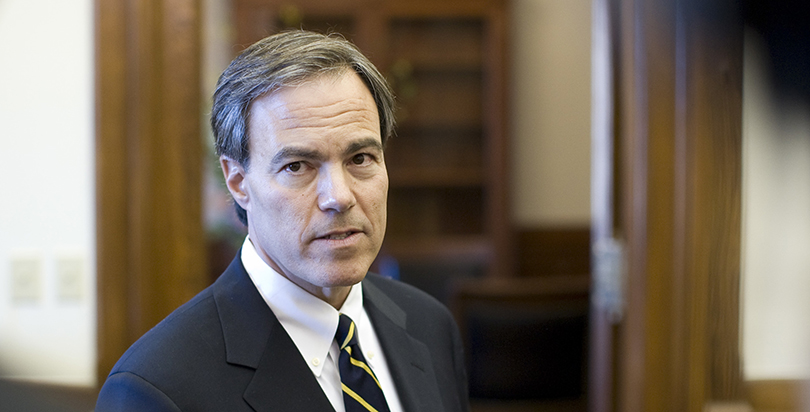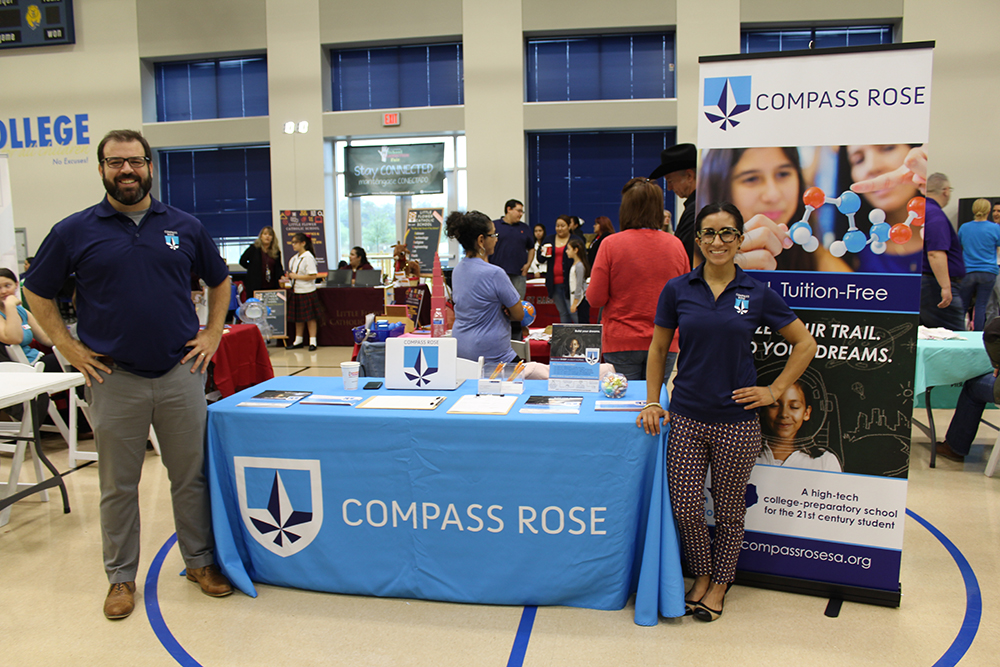San Antonio, Texas
Before she was an organizer with Texans for Quality Public Charter Schools, Rosa Turner was the mother of a little girl who attended the elementary school Escuela de las Americas in San Antonio. The school was located in the poorest neighborhood in a city characterized by profound poverty, where parents were more likely to be working multiple jobs than volunteering in the classroom.
Turner, however, had the time to help. She started out motivated to make sure her own daughter succeeded in school, but she quickly found herself watching over her girl’s classmates. She got in the habit of hanging out as parents picked up their kids, reporting to them about the day and troubleshooting problems.
“I embraced those kids,” she says. “Their parents are busy. They’d say to me, ‘Hey Comadre, el bus no vino—the bus never came.’ So I’d find out different things about the transportation.”
Turner became the go-to parent. And when financial pressures forced the school’s closure, the stakes associated with being the mother with answers skyrocketed.
“Parents were asking, ‘What is a good school?’ ” she says. “All the parents, what they want is a career for their child, college for their child.”
The more Turner learned, the more convinced she became that San Antonio’s kids needed a new kind of advocacy. The parents coming up behind her needed to understand how events at the State Capitol Building in Austin, 80 miles to the north, shaped families’ day-to-day concerns. And instead of learning this the hard way, over the course of years of navigating the system, they needed this knowledge when their children were young and they were picking their first school.
Like in many low-income cities, finding a good school in San Antonio is no mean feat. The income disparities among the 19 school districts in metropolitan Bexar County are among the
widest in the nation.
Critics assert that Texas has some of the lowest academic standards, yet
more than three dozen area schools last year failed to meet even basic state expectations.
Officials have no incentive to provide information that would allow parents to evaluate a school’s quality or to help them decode what information they can find. Nor does anyone want to explain why schools serving some ZIP codes do better than those serving others, or why students who share the same challenges languish in one and flourish in another.
Parents in search of alternatives can find negotiating the varying enrollment processes of the city’s charter schools confounding and the length of their waiting lists depressing. For the current school year, for instance, Texas’s 47 KIPP charter schools in Dallas–Fort Worth, Houston, Austin and San Antonio had more than 25,000 applications for about 4,900 seats, according to the high-performing network. Statewide, 141,000 students are on charter school waiting lists, according to the Texas Charter School Association.
The association’s list includes data from 50 percent of Texas charter schools. Students may be on more than one school’s waiting list. Even allowing for the possibility that some student names may appear more than once, that number still speaks to significant family demand.
That demand is being seen and felt in an unlikely coalition of parents from starkly contrasting socioeconomic backgrounds who have come together to push the state legislature, which meets only every other year, to address the issue. Black and Latino parents, like Turner, have been caravanning to the Capitol for years to advocate for their schools. This year they were joined by wealthy families.
Regardless of their background, the parents needed to make lawmakers understand the agony of the wait list. And because they captured families’ addresses, the lists have become a powerful tool for mobilizing parents to put pressure on lawmakers.
Motivating the House Speaker
Texas is home to several successful networks of charter schools that, lacking the same tools traditional district schools have for remodeling or building facilities, can’t expand to meet demand. The independent schools can’t raise taxpayer money via referenda, nor do they get the same state backing that traditional districts do to borrow from the bond market at a low cost.
A handful of charter schools that meet a narrow set of requirements can apply for funds from a pot of state construction money. But of the state’s 195 charter holders, just 14 qualify.
Over the past decade, the Republican-dominated state House of Representatives has blocked numerous education reform measures, including potential fixes to the facilities funding inequity. Conventional wisdom has been that in the past, House Speaker Joe Straus has had little incentive to break the logjam.
The new parent coalition, which includes families who live down the street from Straus — indeed, some who are childhood friends, according to people in their social circles — wants to provide that motivation.
Great schools, wrong fit
A rainy December day found Turner talking to parents at a school choice fair hosted by Families Empowered, a Houston nonprofit that helps people navigate their school choices. On behalf of the coalition Texans for Quality Public Charter Schools, Turner is collecting letters to deliver to lawmakers.
Across the gym, Families Empowered staffer Inga Cotton is taking pictures of the folks representing the schools at the fair. Later she’ll post the portraits to
a Facebook page she moderates, the San Antonio Charter Moms discussion group. It’s a virtual counterpart to the school vestibule where Turner got her advocacy start, with Cotton dipping into comments and posts on the page to supply factual information about enrollment lotteries, new schools and family events.
Cotton’s home school district, Alamo Heights, presents a stark contrast to Turner’s. A wealthy suburb northeast of downtown San Antonio, it’s the kind of bedroom community families of means move to specifically for the schools. Increasingly, though, Cotton is hearing from neighbors who are ending up on charter waiting lists.
Alamo Heights also is located in Speaker Straus’s district. Two years ago, Cotton was one of the San Antonio parents who piled onto buses during National School Choice Week to call on lawmakers in Austin. She met with a member of Straus’s staff who, Cotton recalls, suggested that the parents were at the end of a long line of people who wanted more funding for their particular education priority.
The state Supreme Court last year upheld Texas’s byzantine education funding system but urged the legislature to overhaul it instead of piling “Band-Aid on top of Band-Aid.” The lawsuit in question was filed by more than 600 school districts that charged that state lawmakers’ decision to cut $5.4 billion from schools in 2011 made it impossible to provide an adequate education.
Last fall, Cotton was one of a number of education activists who ponied up $250 a person to attend a fundraiser for Straus at a local steakhouse. Former San Antonio Spurs center David Robinson, who is a regional board member for IDEA Public Schools and who donated a campus to the charter network, was there. Also in attendance were a number of parents from the school Cotton’s children attend, Great Hearts Monte Vista, a popular charter with a curriculum focused on the classics.
“I’m a supporter. I live in your neighborhood,” Cotton told the speaker. “My kids don’t go to Alamo Heights schools. My son has autism.”
Cotton’s son’s struggles with traditional district schools started when he was 4. Where Cotton saw gifts like the keen spatial abilities the boy shared with the orthopedic surgeons and engineers in the family, the school seemed only to see his deficits.
“Kindergarten went downhill fast,” Cotton recalls. “I dropped in unannounced one day and saw how bored he was and how chaotic and overwhelming things were.”
The boy was spending more and more time in a segregated classroom. Cotton began trying — politely but persistently — to get him into a mainstream class for most of the day and, for a few hours a week, gifted and talented services. She felt as if she was getting the runaround.
“I’ve always had this unshakeable conviction that my son [eventually] would be mainstreamed” — included in a regular classroom — she says. “Sure, he’s quirky, but so is everyone in the family.”
The Great Hearts network hadn’t yet opened schools in Texas, but Cotton had heard enough promising stories about the benefits of the schools’ calm and highly structured environment for children with special needs that she traveled to Phoenix to visit one. While she was there, her parents called and said they couldn’t get her son to get on the school bus. Cotton told them to call him in sick. It was April, and it was her breaking point.
When Cotton enrolled her son in Great Hearts Monte Vista later that year, the school’s director of special education requested his file from Alamo Heights.
“I put a cover letter on it that said, ‘Nothing in this describes my child. Please give him a fresh start,’ ” she says. “When I delivered it, I broke down crying. I think I really freaked the special ed guy out. I was like, ‘I have to give you a pile of crap.’ ”
The boy’s teachers immediately recognized his strengths and set high goals for him, Cotton said. By the second semester of his first year at the new school, he was a full participant in a mainstream classroom.
“Alamo Heights [district] schools are great,” Cotton told Straus at the fundraiser. “Alamo Heights schools are not able to take care of my son.”
When the speaker stood to address the group, Cotton heard him reiterate her concerns and those of the other parents with kids in charter schools or on waiting lists.
Charters 101
Margo Mastrud also has children at Great Hearts Monte Vista, which is located near the city center. If traffic is bad, her commute from the western suburb where she lives to school can take two hours in the morning and another two in the afternoon. There are 54 families who make the same crosstown trek, according to a Facebook page set up by other Great Hearts parents in her neighborhood. They dream, Mastrud said, of there being enough funding to open a school on their side of the city.
Her oldest son has three rare learning disorders that are best addressed by an occupational therapist during the preschool years. Mastrud’s neighborhood school, which had just lost its occupational therapist, insisted that her son’s issues weren’t severe enough to warrant therapy.
“Early intervention will make him a better student,” Mastrud argued, to no avail. “I’m like, ‘You’re creating a mediocre student who is going to eventually hate school, and that’s not OK with me.’ ”
When Mastrud first heard that Great Hearts was trying to open two schools in San Antonio, she started attending organizing meetings. She took time off work to go to Austin to show support when the network was applying for permission to open. She got extended family to write letters to the state Board of Education.
When the school was approved in 2012, Mastrud was the first to apply. She was crushed when her son, now in the fourth grade, did not win the admissions lottery. While the boy sat on the waiting list, she homeschooled him, doing her best to emulate the school’s classical approach.
When her son finally got into the school in 2014, his special education teachers identified one more challenge: an atypical form of dyslexia. Like Cotton’s son, he was quickly flourishing in a mainstream classroom, Mastrud said.
Each of the parents Turner and Texans for Quality Public Charter Schools are helping to organize can tell a similar story. Adanary Galindo moved her three children out of the neighborhood where her extended family has deep roots and into a two-bedroom apartment in Great Hearts’ much more expensive neighborhood to eliminate the kind of commute Mastrud endures.
Rachel Allred pulled two of her four children out of Alamo Heights schools after four years of pushing for more challenging work. Her older kids would have 10 minutes of reading instruction at the start of class, she said, after which the kids who got their work done quickly were told to spend the rest of the hour reading independently.
She was spending a fortune on Kindle books and private tutoring when she saw a flier for BASIS, a network of high-performing charter schools that was opening campuses in San Antonio. She flew to Phoenix to tour a BASIS school and came back galvanized to call her friends and tell them what she had seen — kids doing advanced work in an environment that was joyful and energetic. Her two youngest will go to BASIS next year.
Like Turner, Allred spends a lot of time conducting parent engagement sessions the organizers call “Charter 101s.” She’ll invite a handful of interested but hesitant parents to coffee or to visit the cafeteria at her kids’ BASIS school. Most of the time is spent debunking rumors about charter schools.
“What do I say when people say, ‘Oh — you don’t have to take special ed students and that’s why your scores are so high?’ ” she says. “I’m like, ‘Guys, that’s the special ed teacher.’ ”
Texans for Quality Public Charter Schools invested a lot of energy in the Charter 101s last year. Director of community and parent engagement Shree Medlock says having an outside organization concentrate on educating and organizing parents has been key.
“People still don’t know,” says Medlock. “Even in the schools, they [parents] don’t understand what a charter is.”
Nor do principals and teachers feel comfortable asking parents to call their legislators. Having another parent connect the dots is much more effective, she says: “Parents listen to other parents.”
And it helps to translate the impact the funding gap has, not just on the waiting list, but on a school’s ability to offer extracurricular activities, transportation and other services that would directly benefit students. Traditional school districts receive an average of $10,325 in state and local revenue for each student. This is $1,400 more per pupil than charter schools receive. Almost all of the gap is the lack of state facilities funding for charters.
Leaders of well-established networks of charter schools are quick to reel off the things on their wish list they’d use the money to pay for: buses, which would boost attendance, college tours for high schoolers, expanded preschool and more.
Compass Rose is a high-tech charter school slated to open in San Antonio in August.
Photo: Families Empowered
The importance of starting out strong
For a startup, the charter school funding hurdle can feel insurmountable. Paul Morrissey is the executive director of Compass Rose, a high-tech charter school slated to open in August that is working to find a campus. The program is one of just two Texas charters approved last year. It has authority to open three schools over the next five years — provided Morrissey can find the money.
Morrissey had a hard time locating a landlord willing to take a chance on renting to Compass Rose. The school will enroll only sixth-graders its first year, adding a grade every year until its first class graduates high school.
That means its first year the school will get just a sliver of the state funding it will eventually receive. Without the total amount of state tuition funding the school will receive when it’s fully enrolled, Compass Rose won’t be able to afford the renovations to create a school that can accommodate six grades of students. So a landlord must allow it to grow piecemeal.
“It’s threading a needle while riding a horse,” says Morrissey, who has experience both opening new schools and attempting to turn around a traditional district school. “It’s all about how you start in the charter world. Unless you start strong…”
As the sentence trails off, Morrissey shakes his head. Starting strong means delivering the kinds of outcomes even before the first-year test scores are in that will convince families Compass Rose is a good alternative to the existing charter schools where their children are wait-listed. It’s a tough act, especially on a shoestring.
As the legislature convened in January, it was clear the unlikely coalition of parents had gotten Straus’s attention and that of other key lawmakers. Policy aides were taking notes instead of nodding politely. Lawmakers in both chambers have visited schools and sought out parents.
It’s less clear that appropriating money for charter schools in Texas — particularly while oil prices are low — is a feat even a newly sympathetic speaker can pull off.
But with 20 percent to 25 percent of kids in Texas’s largest cities, nearly 400,000 students, either enrolled in a charter school or on a wait list, education advocates see the state’s unusual political landscape starting to change. Demand is thought to be moving Democrats, who traditionally viewed charter schools as a threat to teachers unions, to soften their opposition.
It’s not unusual for an urban Senate district, for example, to be home to 15,000 parents and for 10,000 of them to have wait-listed kids, according to education policy advocates. Much smaller House districts are a harder nut for charter school expansion proponents to crack. In many, the traditional school district is a major employer and doesn’t welcome the competition. The gatekeeper in the House, Straus will need Senate members to compromise on other priorities, which advocates speculate could push him to cede to senators’ wishes on the charter funding issue.
A bill to provide charter schools with $700 per pupil in state facilities aid has been introduced in the Senate. The funding would cut the $1,400 gap between charters and their better-funded district counterparts by half.
District by district, wait-listed parents are making the trip to Austin. And they’re reporting back that the reception is warmer than in years past.
Says Shree Medlock: “Parents are bulldogs, once they know.”



;)
